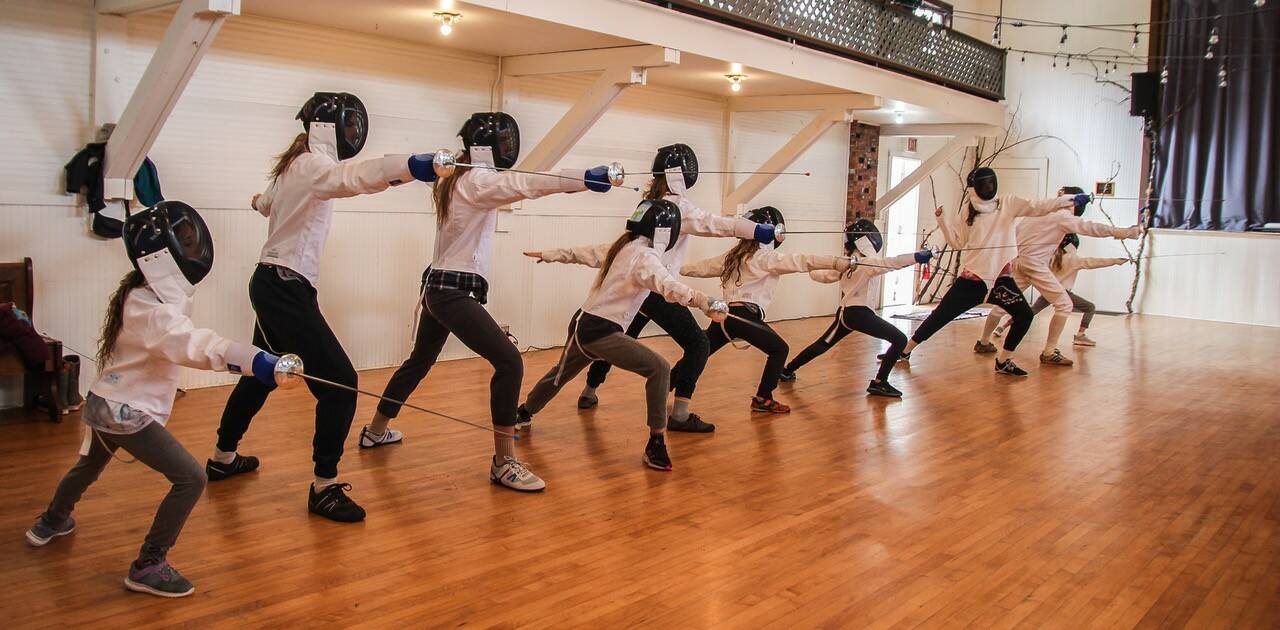After years of practicing with each other, two seasoned fencers are now sharing their sword-fighting expertise with the community in South Whidbey.
South Whidbey residents Bob Tearse and Joseph Kleinman, both of whom have decades of fencing under their belt, recently began teaching homeschooled children and teens the art of fencing with the foil, a weapon with a flexible blade that bends when a touch is scored.
During the lessons, students learn the basics of fencing, such as terminology and how to coordinate footwork and bladework, which they then put into practice by sparring.
One of the first things newbie fencers learn is to keep their free hand out of the way as the hand might get hurt. Someone might instinctively attack in a way that whips their opponent, which can hurt an opponent who is subconsciously shielding their body with their hand.
However, a successful touch isn’t painful if the sword is held the correct way. By bending, the weapons absorb most of the force. Compared to many other sports, fencing is “rather safe,” Tearse said.
“The most I’ve come away from it is with bruises,” he said.
Learning the correct form is also very important. Tearse’s physical problems, for example, were aggravated by not making movements in a safe manner, he said.
When sparring with a foil blade, Kleinman explained, the target area is the torso, starting from the groin to the area under the throat. If a foil fencer hits their opponent on the arm or head, both fencers are stopped and required to be on guard before starting again.
The foil discipline is the most common and uses a 35-inch-long sword that weighs less than a pound.
In about half a century of fencing, Kleinman has defeated two national champions and has medaled in foil, épée and saber.
The épée sword is about the same length as the foil but heavier, with a larger guard to protect the hand and a stiffer blade, and can hit any part of the opponent’s body to score points.
The target area of the saber sword is from the bend of the hips to the top of the head, and, unlike the first two, saber swords can hit the opponent with the edge of the blade — like a slashing cavalry sword, according to USA Fencing’s website.
While Kleinman first got acquainted with the sport in high school back in 1964, Tearse — who wasn’t “big enough for football, tall enough for basketball and adept enough for tennis” — discovered he had a knack for fencing in college. For more than 20 years, he taught students in middle school and high school.
They became fencing partners nine years ago, after Tearse’s wife found Kleinman’s Drewslist announcement that he was looking for someone to fence with.
Though they are both retired, Kleinman and Tearse are still learning from one another and love a good challenge. The two have been practicing three times every week at the Island Athletic Club in Freeland, and welcome anyone to join their sessions at 1 p.m. on Mondays, Wednesdays and Fridays.
Their next competition is scheduled for this Sunday at the Salle Auriol Fencing Club in Seattle.
Kleinman said competing is exciting, nerve-wracking and cathartic at the same time.
“You don’t have anything else to worry about when you’re fencing somebody, it’s like you’re focused on staying alive,” he said. “It’s my anger management tool.”
Tearse compared duels to jazz improvisers who create spontaneous harmonies, as there is a silent communication between the opponents who respond to one another’s every movement. To him, it’s not a matter of life or death, but a challenge to perform at his best, an intellectual effort that he finds relaxing.
Tearse said some people might feel discouraged to try fencing because it’s difficult to appreciate a performance while struggling to keep up with what’s going on.
“Fencing occurs very fast and as quick as people’s reflexes are,” he said. “It’s faster than you can see.”
Kleinman said fencing gets little attention from the general public and even in the sports world, and estimated there are only about 50,000 fencers in the country.
Despite the lack of popularity, the two instructors believe fencing is a great hobby for kids, as it teaches self-discipline and sportsmanship. It also exercises muscles, balance and reflexes.
Ben and Rhyze Greer, respectively father and son, came across Kleinman and Tearse while they were fencing outside, and were immediately hooked. Now, they go to class together.
To Ben Greer, the sport is appealing because, despite looking easy from the outside, it’s actually challenging.
“If it’s too simple, the kids don’t really want to do it. But it has to be simple enough that they can get into it,” he said.
Though it currently counts homeschooled youths and one adult, the class is open to anyone over the age of about 8 years old, according to the instructors. Tuesday morning, the class was held at the Bayview Community Hall in Langley, though location and timing is currently “at the convenience of the homeschool families” who are renting the community hall, Tearse said.
If the class attracts more students, Kleinman and Tearse might be able to offer more classes and possibly an adult class. Ideally, the class would take place in a large indoor space with a wooden floor, like a basketball court.
For more information, reach out to Joseph Kleinman at jobar@whidbey.com, or to Courtney Cooke, a parent, at courtneycooke@gmail.com.


